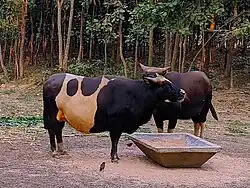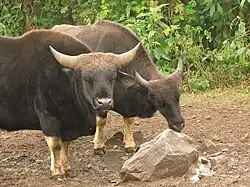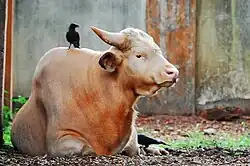Gayal
| Gayal | |
|---|---|

| |
| Gayals at Gazipur Safari Park, Bangladesh | |
Domesticated
| |
| Scientific classification | |
| Kingdom: | Animalia |
| Phylum: | Chordata |
| Class: | Mammalia |
| Order: | Artiodactyla |
| Suborder: | Ruminantia |
| Infraorder: | Pecora |
| Family: | Bovidae |
| Subfamily: | Bovinae |
| Genus: | Bos |
| Species: | B. frontalis
|
| Binomial name | |
| Bos frontalis Lambert, 1804
| |
| Synonyms | |
| |
The gayal (Bos frontalis), also known as mithun and drung ox,[1] is a large semi-domesticated cattle in the Himalayan foothills of South and primarily in Northeast India.
Taxonomy
In his first description of 1804, Aylmer Bourke Lambert applied the binomial Bos frontalis to a domestic specimen probably from Chittagong.[2][3]
In 2003, the International Commission on Zoological Nomenclature fixed the first available specific name based on a wild population that the name for this wild species is valid by virtue of its being antedated by a name based on a domestic form. Most authors have adopted the binomial Bos frontalis for the domestic species as valid for the taxon.[4]
Phylogenetic analysis corroborates the taxonomic assessment that the gayal is an independent Bos species originating matrilineally from gaur, zebu and cattle.[5]
Characteristics
The gayal differs in several important particulars from the gaur:[6]
- It is somewhat smaller, with proportionately shorter limbs, and stands much lower at the withers.
- The ridge on the back is less developed, and bulls have a larger dewlap on the throat.
- The head is shorter and broader, with a perfectly flat forehead and a straight line between the bases of the horns.
- The thick and massive horns are less flattened and much less curved than in the gaur, extending almost directly outwards from the sides of the head, and curving somewhat upwards at the tips, but without any inward inclination. Their extremities are thus much farther apart than in the gaur.
- The female gayal is much smaller than the bull, and has scarcely any dewlap on the throat.
- The skin colour of the head and body is blackish-brown in both sexes, and the lower portion of the limbs are white or yellowish.
- The horns are of uniform blackish tint from base to tip.
Some domesticated gayals are parti-coloured, while others are completely white.
There are two major hypotheses on the origin of the gayal:
- It was domesticated from wild gaur;[7]
- It is a hybrid descendant from crossing of wild gaur and domestic cattle, either Bos indicus or Bos taurus.[8]
In 2020, Ranganathan Kamalakkannan et Al. found "phylogenetic analysis using complete mitochondrial genome sequences unambiguously suggested that gaur is the maternal ancestor of domestic mithun."[9][10]
A 2021 literature review by Dorji et. al. found that gayal were domesticated over 8,000 years ago along the Assam-Burma border, with wild gaur the most likely ancestor along with some gene introgression from zebu, Southern yellow cattle, and cattle.[11] Analysis of the genome of the gayal was published in 2017.[12]
Distribution and habitat

Gayal occur on the southern slopes of the Eastern Himalayas in Northeast India, Bangladesh, Myanmar and in Yunnan, China at elevations of 300 to 5,000 m (980 to 16,400 ft) and temperature ranges from 20 to 30 °C (68 to 86 °F). Their preferred habitat is characterized by undisturbed forested regions on hilly terrain with streams, ponds, and lakes where abundant shrubs, trees, bamboo, and coarse grasses can be found. They are also drawn to salt lick hotspots.[11]
In India, semi-domesticated gayals are kept by several ethnic groups living in the forested hills of Tripura, Mizoram, Assam, Arunachal Pradesh, Manipur and Nagaland. They also occur in the Chittagong Hill Tracts.[6] In northern Burma, they occur in the Kachin State, and in adjacent Yunnan only in the Trung (Chinese: 独龙河) and Salween River basins.[13][7]
Gayal serve an important ecological function and in northeast India function as ecosystem engineers, aiding in seed dispersal and enriching soil through their foraging activities and manure.[14]
The role of the gayal is central to the lives of many residents of these areas, including transhumant ones who pair gayal herding with sago palm harvesting:
Although livestock is highly characteristic of the high Himalayan way of life in general, with yaks and sheep being predominant species until recently, the mithun, or gayal (Bos frontalis) is the most prominent animal exploited by Eastern Himalayan groups ... The mithun is a semi-domesticate, managed in fenced tracts of forests rather than being kept in or near villages. Outside North East India, mithun are primarily imported for the purpose of cross- breeding with other bovids, for example in Bhutan. It is very common among Eastern Himalayan languages to find lexical sets denoting fauna in which the mithun is lexicalized as a "prototypical" meat animal, with all other terms being derived ... Terms for 'mithun' in other languages of Arunachal Pradesh are typically cognate with Aka fu (e.g. Miji ʃu, Koro sù, Puroik ʧa and Proto-Tani *ɕo), suggesting that this is probably not a case of semantic shift from a wild species. The implication is that the semi-wild mithun was seen as the core species, and the true domesticates such as cattle, which arrived subsequently, as marginal to the system.[15]
In culture

The gayal is the state animal of Arunachal Pradesh and Nagaland. Gayal are reared for meat, milk, and ceremonial purposes, and are of economic, social, and cultural importance in many different ethnic groups in its range. They are known primarily as a meat animal, being used most often as a dairy animal in Northeast India and Bhutan. 24 ethnic groups across China, Bangladesh, Myanmar, and India have been recorded as being associated with gayal farming.[11]
The gayal is particularly important in the lifeways of the Tani peoples, including the Idu Mishmi, Nyishi, Galo, Adi (Bangni-Booker Lhobas including Pasi, Padam, Minyong), and of the Naga peoples, including the Ao Naga, Chang Naga, Konyak Naga, Khiamniungan Naga, Sangtam Naga, Sümi Naga, and Yimkhiung Naga. Gayal ownership is generally a signal of prosperity and high social status, and they are traditionally used as a form of currency, being exchanged for goods and alliances and used to pay fines and dowries. They also play a central role in religious ceremonies as a sacrifical animal or as a source of meat for festivals, feasts, religious and cultural events, and social gatherings. Sacrifice of a gayal generally is considered to bring honor and fortune to an individual or group, appease deities, and bring blessings, and the meat and blood of sacrificed gayal is auspicious.[16]
For Galo people, gayal are a symbol of peace and harmonity in the community, and an individual or family's wealth is measured by how many gayal they own. In Gallong, they are called hobo. During the Mopin festival held on April 5th, gayal are sacrified as offerings to the harvest goddess Mopin Ane, to bring a good harvest and a prosperous new year. Gayal are also part of the traditional dowry, with the groom's family gifting gayal to the bride's family. The amount and quality of the gayal gifted can be considered as both an indicator of the groom's family's status as well as an indicator of the bride's status.
In Naga folklore, man and gayal shared the same womb, which formed the basis for the close bond between the two species today. Gayal are a potent symbol of wealth, propserity, and fertility. Carvings of gayal heads on the façades of homes are used to signify the social status of the residents. Among the Adi of Arunachal Pradesh, marriages are not fixed until the bridegroom's family gives at least one gayal to the bride's household.[17][16]
Gayal are not not commonly milked outside of Northeast India, and generally are not put to work. As gayal are semi-wild, traditionally they have been allowed to roam and forage freely in forests and return of their own accord, being given supplementary care by the herd owner. More contemporary practices have shifted towards creating fences, often living fences, to prevent gayal from straying into crop fields, where they can be shot and killed by farmers or cause crop damage which incurs a fine for their owners. It has also become increasingly common to call gayal back to the herd owners' pasture or barn on a nightly basis, in part due to the loss of livestock, especially calves, caused by dhole (Cuon alpinus) predation.[14]
National Research Centre on Mithun
The National Research Centre on Mithun was established at Medziphema in the Chümoukedima District of Nagaland under the Indian Council of Agricultural Research.
The mandate of the institute was redefined in 1997 and 2006. Currently, the National Research Centre on Mithun is functioning for developing the scientific and sustainable mithun rearing system and for catering the needs of mithun farmers with the following mandates:
- Identification, evaluation and characterization of mithun germplasm available in the country.
- Conservation and improvement of mithun for meat and milk.
- Act as a repository of germplasm and information centre on mithun.
References
- ^ Scherf, B. (2000). "World Watch List for Domestic Animal Diversity" (PDF). World Watch List for Domestic Animal Diversity. FAO: 651.
- ^ Linnean Society of London.; London, Linnean Society of; London, Linnean Society of (1804). Transactions of the Linnean Society of London. Vol. v.7 (1804). London: [The Society], 1791-1875.
- ^ Ellerman, J. R.; Morrison-Scott, T. C. S. (1966). Checklist of Palaearctic and Indian mammals 1758 to 1946 (Second ed.). London: British Museum of Natural History. p. 380.
- ^ Gentry, A.; Clutton-Brock, J.; Groves, C. P. (2004). "The naming of wild animal species and their domestic derivatives" (PDF). Journal of Archaeological Science. 31 (5): 645–651. Bibcode:2004JArSc..31..645G. doi:10.1016/j.jas.2003.10.006. Archived from the original (PDF) on 2011-04-08.
- ^ Guolong, M.; Hong, C.; Shiping, L.; Hongyu, C.; Dejun, J.; Rongqing, G.; Chunfang, C.; Yonghong, L. (2007). "Phylogenetic Relationships and Status Quo of Colonies for Gayal Based on Analysis of Cytochrome b Gene Partial Sequences". Journal of Genetics and Genomics. 34 (5): 413–419. doi:10.1016/S1673-8527(07)60045-9. PMID 17560527.
- ^ a b Lydekker, R. (1888–1890). The new natural history. Vol. 2. London: Trustees of the British Museum (Natural History). pp. 179–181.
- ^ a b Simoons, F.J. (1984). "Gayal or mithan". In Mason; I.L. (eds.). Evolution of Domesticated Animals. London: Longman. pp. 34–38.
- ^ Payne, W. J. A. (1970). "Breeds and Breeding VI". Cattle Production in the Tropics: General introduction and breeds. London: Longman Group Ltd.
- ^ Kamalakkannan, Ranganathan (20 July 2020). "The complete mitochondrial genome of Indian gaur, Bos gaurus and its phylogenetic implications". Sci Rep. 10 (11936) 11936. Bibcode:2020NatSR..1011936K. doi:10.1038/s41598-020-68724-6. PMC 7371690. PMID 32686769.
- ^ Uzzaman, M. R.; Bhuiyan, M. S. A.; Edea, Z.; Kim, K.-S. (2014). "Semi-domesticated and Irreplaceable Genetic Resource Gayal (Bos frontalis) Needs Effective Genetic Conservation in Bangladesh: A Review". Asian-Australasian Journal of Animal Sciences. 27 (9): 1368–1372. doi:10.5713/ajas.2014.14159. ISSN 1011-2367. PMC 4150205. PMID 25178382.
- ^ a b c Dorji, Tashi; Wangdi, Jigme; Shaoliang, Yi; Chettri, Nakul; Wangchuk, Kesang (November 2021). "Mithun (Bos frontalis): the neglected cattle species and their significance to ethnic communities in the Eastern Himalaya - A review". Animal Bioscience. 34 (11): 1727–1738. doi:10.5713/ab.21.0020. ISSN 2765-0189. PMC 8563247. PMID 33902178.
- ^ Zhang, Y.-P.; Wu, D.-D.; Dong, Y.; Wang, W.; Yang, M.-M.; Yan, S.-Q.; Qu, K.-X.; Wang, S.; Xiong, Z.-J. (2017). "Draft genome of the gayal, Bos frontalis". GigaScience. 6 (11): 1–7. doi:10.1093/gigascience/gix094. PMC 5710521. PMID 29048483.
- ^ Siddiqui, S. A.; Schulte, H.; Golik, A. B.; Pandiselvam, R.; Venkidasamy, B.; Homayouni-Rad, A.; Maqsood, S. (2024). "Traditional and commercial dairy products from yak, camel, zebu-brahma, mithun, reindeer and sow - A review on current research status". International Dairy Journal. 152 105879. doi:10.1016/j.idairyj.2023.105879.
- ^ a b "The indigenous community protecting Himalayan sacred cattle in India". BBC. 2024. Retrieved 2025-08-17.
- ^ Blench, R.; Post, M. W. (2013). "Rethinking Sino-Tibetan phylogeny from the perspective of North East Indian languages". In Owen-Smith, T.; Hill, N. (eds.). Trans-Himalayan Linguistics Historical and Descriptive Linguistics of the Himalayan Area. Berlin: De Gruyter. pp. 71–104. ISBN 978-3-11-031083-2.
- ^ a b Bora, B. (2025). "Unlocking the Potential of Mithun: An Indigenous Treasure for Meat, Milk and Leather in Northeast India". Just Veterinary. 3 (1): 224–226.
- ^ Narendra, V.N.; Chaithrashree, J. (2023). "The Mithun (Bos frontalis): A Review of Its Significance as 4 Ms (Meat, Money, Milk and Marriage) of Naga Tribes of India" (PDF). Biotica Research Today. 5 (6): 407–409.